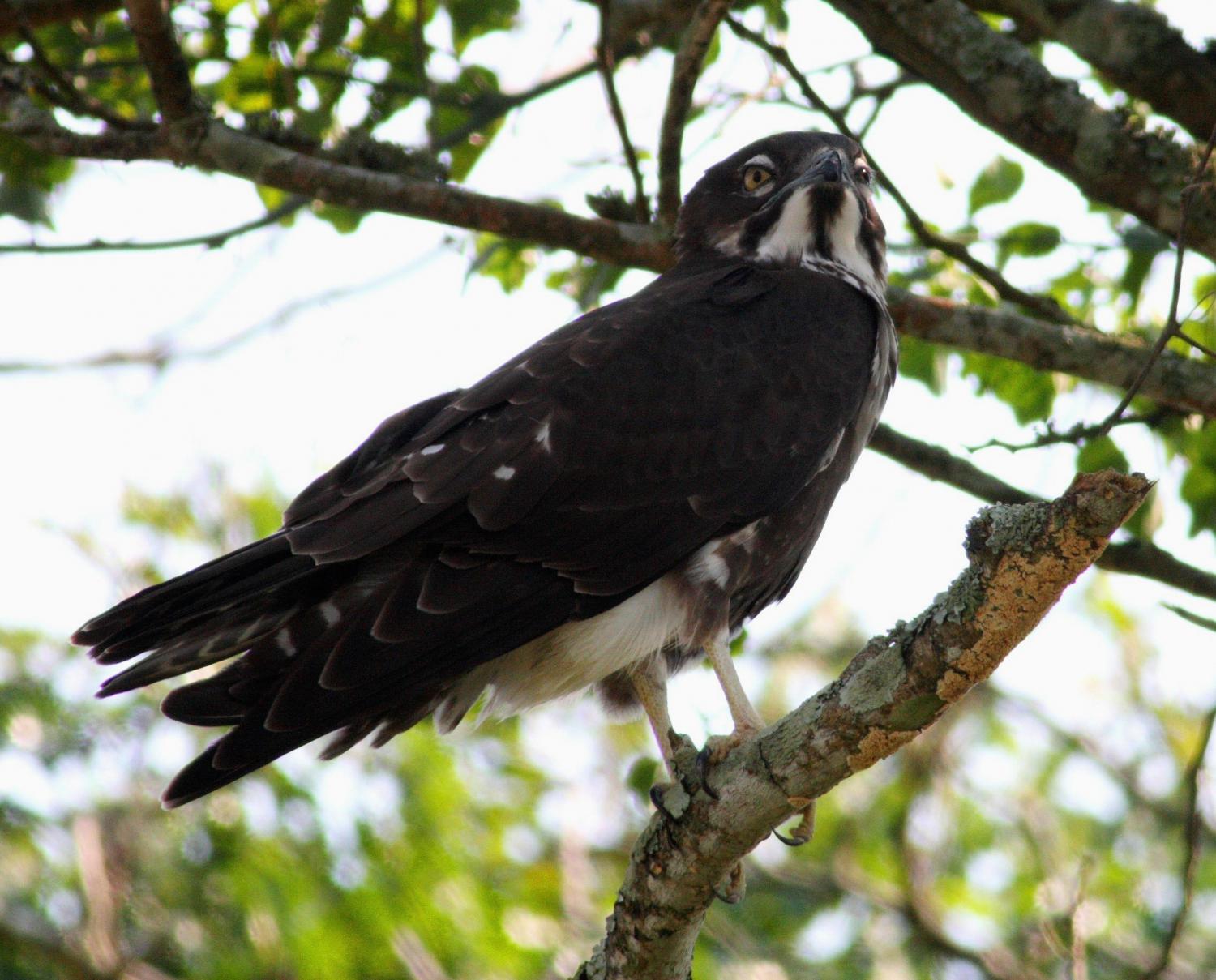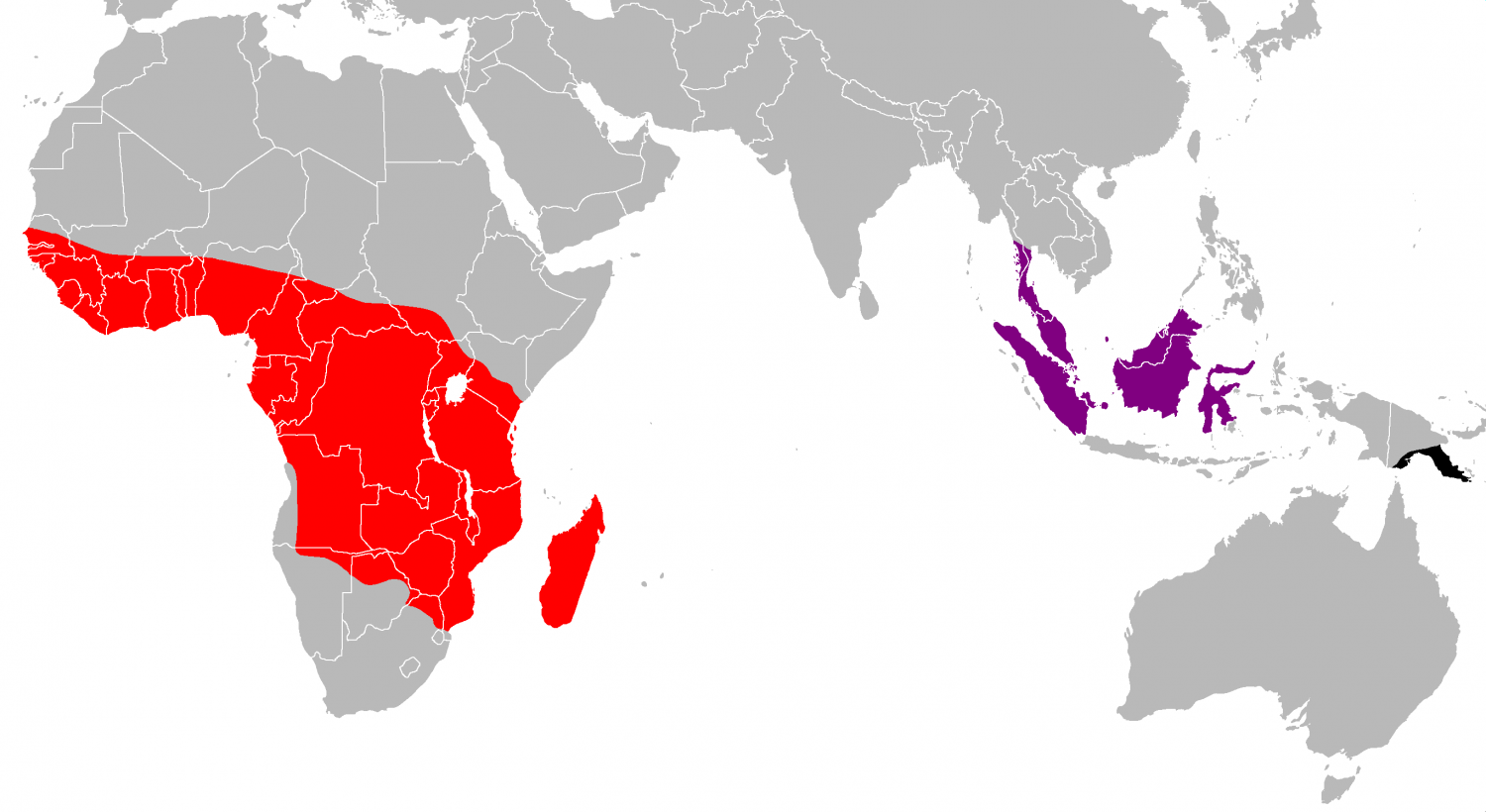Species of Thailand
Bat hawk
Macheiramphus alcinus
Charles Lucien Bonaparte, 1850
In Thai: เหยี่ยวค้างคาว
The bat hawk (Macheiramphus alcinus) is a raptor found in sub-Saharan Africa and south Asia to New Guinea. It is named for its diet, which consists mainly of bats. It requires open space in which to hunt, but will live anywhere from dense rainforest to semi-arid veld.
Description
The bat hawk is a slender, medium-sized bird of prey, usually about 45 cm long. It has long wings and a falcon-like silhouette while in flight. Adults are dark brown or black, with a white patch on the throat and chest, and have a white streak above and below each eye. Juveniles are mottled brown and have more white plumage than adults.
Hunting
Bats are the usual prey of the bat hawk, although they may eat small birds, such as swallows, swifts, and nightjars, or even insects. They hunt by chasing their prey at high speeds in flight. 49.3% of their hunts are successful. Once caught the bat is processed very rapidly and the mechanism with which bat hawks kill their prey is still unknown. Bat hawks also show very rapid ingestion rates, taking on average 6 seconds for the prey to reach the stomach after capture.
The bat hawk is crepuscular and hunts at dusk. They feed on the wing and swallow their prey whole. This feeding habit has resulted in the evolution of an unusually large gape, the largest of any raptor relative to body size, and is more similar to that of insectivorous birds which feed on the wing such as swallows, swifts and nightjars.
Breeding
Courtship involves many aerial displays and stunts. The nest is built with sticks gathered in flight, and is about 90 cm across and 30 cm deep. The female is solely responsible for incubating her clutch. The male often shares food with her. About a month after incubation begins, the eggs hatch, and both parents help to feed their young. 30–45 days after hatching, the young fledge. They leave the nest soon after. Bat hawks time their breeding cycles with those of bats, taking advantage of lethargic pregnant females in order to attain breeding condition, whereas fledglings take advantage of young bats which have recently taken to the air.
Bat hawks breed most years.
Conservation
Due to its large range and relatively stable population, the bat hawk is of least concern. However, localized populations are under threat, and it is listed as Endangered in South Africa.
Etymology
The genus name is from Greek: meaning knife; and , bill. The specific epithet alcinus means like an auk, from Linnaeus' genus Alca, which is also a reference to the bat hawk's thin bill.
Taxonomy
The spelling of the genus name is problematic. Charles Lucien Bonaparte described the bat hawk in 1850, naming it Macheiramphus alcinus. Westerman described it in 1851 under the name Machaerhamphus alcinus, and this form was used for over a hundred years because it was believed to have been published in 1848. In 1960 Deignan pointed out that Bonaparte has priority, but in 1979 Amadon claimed that Macheiramphus alcinus is an abandoned name. Brooke and Clancey note that the preservation of a junior synonym requires a special ruling from the ICZN that Amadon didn't obtain; whilst Dickinson argues that Deignan's resurrection of the name in 1960 should stand because it predates the first edition of the Code in 1961.
This article uses material from Wikipedia released under the Creative Commons Attribution-Share-Alike Licence 3.0. Eventual photos shown in this page may or may not be from Wikipedia, please see the license details for photos in photo by-lines.
Category / Seasonal Status
BCST Category: Recorded in an apparently wild state within the last 50 years
BCST Seasonal status: Resident or presumed resident
Scientific classification
- Kingdom
- Animalia
- Phylum
- Chordata
- Class
- Aves
- Order
- Accipitriformes
- Family
- Accipitridae
- Genus
- Macheiramphus
- Species
- Macheiramphus alcinus
Common names
- Thai: เหยี่ยวค้างคาว
Photos
Please help us review the bird photos if wrong ones are used. We can be reached via our contact us page.
Range Map

- Hala-Bala Wildlife Sanctuary
- Kaeng Krung National Park
- Khao Luang National Park
- Khao Nam Khang National Park
- Khao Phra - Bang Khram Wildlife Sanctuary
- Khao Sok National Park
- Khlong Saeng Wildlife Sanctuary
- San Kala Khiri National Park
- Thale Ban National Park



